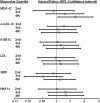The levels of MDA-LDL in circulating immune complexes predict myocardial infarction in the VADT study
- PMID: 22963984
- PMCID: PMC4240617
- DOI: 10.1016/j.atherosclerosis.2012.08.006
The levels of MDA-LDL in circulating immune complexes predict myocardial infarction in the VADT study
Abstract
Objective: Circulating immune complexes (IC) containing modified forms of LDL (mLDL) are strongly pro-inflammatory and strong predictors of cardiovascular disease (CVD) progression in type 1 diabetes. The present study was undertaken to determine whether the levels of oxidized LDL (oxLDL), malondialdehyde-LDL (MDA-LDL) and advanced glycation end products-LDL (AGE-LDL) in IC predict incident CVD events in type 2 diabetes (VADT cohort).
Methods and results: Levels of mLDL in IC were measured in 907 patients of the VADT cohort, a median of two years after entry into the study. Participants were followed for an average of 3.7 years for vascular outcomes. Hazard ratios (HRs) for CV endpoints in relation to mLDL-IC quartiles were calculated by Cox proportional hazard models. The primary composite CVD endpoint included documented myocardial infarction (MI); stroke; death from CVD; congestive heart failure; cardiac, cerebrovascular, or peripheral VD surgical intervention; inoperable CVD; and amputation for ischemic gangrene. During follow-up, 4.7% and 16.8% of participants had an MI or a composite endpoint, respectively. After adjustments by conventional risk factors, individuals in the highest quartile of MDA-LDL-IC were at higher risk of MI [HR = 2.44 (95% CI: 1.03, 5.77)] and composite endpoint [HR = 1.71 (95% CI: 1.04, 2.80)], relative to individuals in the lowest quartile. Similar comparisons for oxLDL and AGE-LDL levels yielded HR values of 1.08 and 1.31 for MI and 0.91 and 1.34 for composite endpoint.
Conclusions: Our study indicates that high levels of MDA-LDL in isolated IC predict future MI and acute CV events in patients with type 2 diabetes.
Published by Elsevier Ireland Ltd.
Figures

Similar articles
-
High levels of AGE-LDL, and of IgG antibodies reacting with MDA-lysine epitopes expressed by oxLDL and MDA-LDL in circulating immune complexes predict macroalbuminuria in patients with type 2 diabetes.J Diabetes Complications. 2016 May-Jun;30(4):693-9. doi: 10.1016/j.jdiacomp.2016.01.012. Epub 2016 Jan 14. J Diabetes Complications. 2016. PMID: 26861948
-
Levels of oxidized LDL and advanced glycation end products-modified LDL in circulating immune complexes are strongly associated with increased levels of carotid intima-media thickness and its progression in type 1 diabetes.Diabetes. 2011 Feb;60(2):582-9. doi: 10.2337/db10-0915. Epub 2010 Oct 27. Diabetes. 2011. PMID: 20980456 Free PMC article. Clinical Trial.
-
Relationship of Autoantibodies to MDA-LDL and ApoB-Immune Complexes to Sex, Ethnicity, Subclinical Atherosclerosis, and Cardiovascular Events.Arterioscler Thromb Vasc Biol. 2017 Jun;37(6):1213-1221. doi: 10.1161/ATVBAHA.117.309101. Epub 2017 May 4. Arterioscler Thromb Vasc Biol. 2017. PMID: 28473443 Free PMC article.
-
Pathogenic role of modified LDL antibodies and immune complexes in atherosclerosis.J Atheroscler Thromb. 2013;20(10):743-54. doi: 10.5551/jat.19281. Epub 2013 Aug 20. J Atheroscler Thromb. 2013. PMID: 23965492 Review.
-
Modified LDL Immune Complexes and Cardiovascular Disease.Curr Med Chem. 2019;26(9):1680-1692. doi: 10.2174/0929867325666180524114429. Curr Med Chem. 2019. PMID: 29792135 Review.
Cited by
-
Aggregation Susceptibility of Low-Density Lipoproteins-A Novel Modifiable Biomarker of Cardiovascular Risk.J Clin Med. 2021 Apr 19;10(8):1769. doi: 10.3390/jcm10081769. J Clin Med. 2021. PMID: 33921661 Free PMC article. Review.
-
Sialic acid as the potential link between lipid metabolism and inflammation in the pathogenesis of atherosclerosis.Braz J Med Biol Res. 2023 Dec 11;56:e12972. doi: 10.1590/1414-431X2023e12972. eCollection 2023. Braz J Med Biol Res. 2023. PMID: 38088673 Free PMC article. Review.
-
Malondialdehyde mediates oxidized LDL-induced coronary toxicity through the Akt-FGF2 pathway via DNA methylation.J Biomed Sci. 2014 Feb 3;21(1):11. doi: 10.1186/1423-0127-21-11. J Biomed Sci. 2014. PMID: 24490960 Free PMC article.
-
The Dual Role of Oxidative Stress in Atherosclerosis and Coronary Artery Disease: Pathological Mechanisms and Diagnostic Potential.Antioxidants (Basel). 2025 Feb 26;14(3):275. doi: 10.3390/antiox14030275. Antioxidants (Basel). 2025. PMID: 40227238 Free PMC article. Review.
-
Plasma Connective Tissue Growth Factor (CTGF/CCN2) Levels Predict Myocardial Infarction in the Veterans Affairs Diabetes Trial (VADT) Cohort.Diabetes Care. 2018 Apr;41(4):840-846. doi: 10.2337/dc17-2083. Epub 2018 Jan 30. Diabetes Care. 2018. PMID: 29382658 Free PMC article.
References
-
- Ross R. Atherosclerosis-An inflammatory disease. N Eng J Med. 1999;340:115–26. - PubMed
-
- De Boer OJ, van der Wal AC, Verhagen CE, et al. Cytokin secretion profiles of cloned T cells from human aortic atherosclerotic plaques. J Pathol. 1999;188:174–9. - PubMed
-
- Hansson GK, Jonasson L, Lojsthed B, et al. Localization of T lymphocytes and macrophages in fibrous and complicated human atherosclerotic plaques. Atherosclerosis. 1988;72:135–41. - PubMed
-
- Lundberg AM, Hansson GK. Innate immune signals in atherosclerosis. Clin Immunol. 2010;134:5–24. - PubMed
-
- Hansson GK. Inflammation, atherosclerosis, and coronary artery disease. N Engl J Med. 2005;352:1685–95. - PubMed
Publication types
MeSH terms
Substances
Grants and funding
LinkOut - more resources
Full Text Sources
Medical

